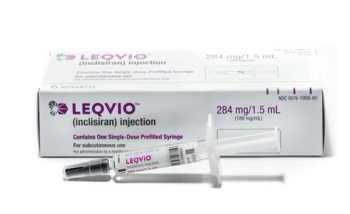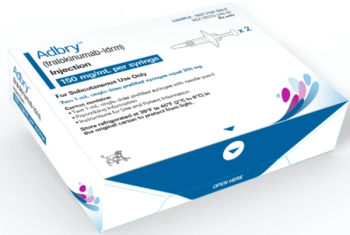
Inclisiran treats adults with heterozygous familial hypercholesterolemia or clinical atherosclerotic cardiovascular disease who require additional lowering of low-density lipoprotein cholesterol.

Inclisiran treats adults with heterozygous familial hypercholesterolemia or clinical atherosclerotic cardiovascular disease who require additional lowering of low-density lipoprotein cholesterol.

Giant cell arteritis frequently causes headaches, scalp tenderness, jaw pain and vision problems.

These individuals also receive immunosuppressive drugs that often impair the immune responses to the vaccinations, study results show.

These mothers are approximately 17% less likely to die from cardiovascular disease, 14% less likely to develop coronary heart disease, and 12% less likely to suffer a stroke, the data show.

Pharmacists can field dermatological questions and help provide relief for this uncomfortable ailment,

The FDA granted priority review to the combination of relatlimab and nivolumab in September 2021 based on the results of this study.

Compensation was a positive, while workload, management, and lack of work/life balance are the top reasons for dissatisfaction.

The research team hypothesized that younger people having more social contacts across age groups and the timing of vaccinations could have made a difference.

Finding ways to eliminate barriers to care helps narrow the gap.

The data were used to evaluate effect of the ACA state Medicaid on insurance coverage, health care use, and health outcomes measured between 1 month prior to conception through 1 year postpartum, and neonatal outcomes within 27 days of birth.

Ensovibep has met the primary endpoint of viral load reduction over 8 days in a phase 2 study, the companies said.

More aggressive competition and uptake could cause larger cuts, estimated at up to $124.5 billion between 2021 and 2025, according to the results of a RAND corporation analysis.

Study strongly supports the CDC’s guidance that booster shots are appropriate for anyone ages 16 and older, and that mRNA vaccines are preferred.

Ten quiz questions to assess your knowledge on common symptoms and treatments for atrial fibrillation.

The study findings support reevaluating how to treat future patients and implications for genetic counseling, according to the authors.

Analysis examines the impacted of expected trends in exposure to high blood sugar, low education levels, obesity, and smoking.

Royal Jelly is rich in proteins, fatty acids, vitamins, minerals, enzymes, carotenoids, and bioflavonoids.

Although fewer than 1 in 5 adults with type 2 diabetes are meeting targets to reduce heart disease risk, available therapies can help when combined with new approaches that barriers to care.

Tralokinumab-ldrm is a human immunoglobulin G4 monoclonal antibody indicated for the treatment of moderate-to-severe atopic dermatitis.

A single shot protects for up to 6 months against breakthrough infections, hospitalizations, and intensive care unit admissions, Johnson & Johnson says.

A goiter may be associated with an increase or decrease in thyroid hormones.

Daridorexant (Quviviq, Idorsia Pharmaceuticals) is indicated for adults who experience difficulties with sleep onset and/or sleep maintenance.

Out of the 3959 who were a part of the study, 2403 of the individuals were vaccinated and 1556 were unvaccinated.

About 48% of individuals experienced a complete or partial response when treated with pembrolizumab, and about two-thirds also had a response that lasted more than 3 years.

Emicizumab (Hemlibra, Roche) is indicated for routine prophylaxis to prevent or reduce the frequency of bleeding episodes in adults and children with hemophilia A with or without factor VIII inhibitors.

Incorporating mental distress screenings during cancer care have been historically difficult, despite the fact that these patients tend to be vulnerable to mental health challenges.

Carol Routledge, PhD, chief medical and scientific officer at Small Pharma, discusses DMT, how it differs from other psychedelic medicines, and what the future holds for DMT-assisted treatments.

The agency previously granted a priority review for the supplemental new drug application and also approved the drug in 2015 to treat adults.

Despite best practice recommendations, prescriptions for acute pharyngitis are frequently not accompanied by testing, Epic Research data show.

CeraVe treats or prevents dry skin, as well as chapped lips, diaper rash, and cold sores, among other conditions.